| 1984 MONTHLY PICTURE |
|
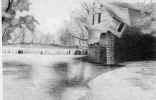 (click on picture to see an enlarged view)
JANUARY - (Butlersville Mill and Dam - drawn by
Sherry Wade - 12th grade) |
One of the three water-powered
grist mills which existed in Allen County in the mid to late 1800's, this picturesque mill
and dam was located at Butlersville, about 10 miles west of Scottsville. In its early
days, the mill ground both wheat and corn - later only corn. Many other people of this
area can recall going to Butlersville "to mill". There was also a post office
and two stores. In its later years, the corn which was ground into meal by the mill
carried the "Star" brand. A picture of a red star was printed on its brown paper
sacks. As far back as anyone can remember, the Rev. William (Willie) Thomas and his
father-in-law, Alf Wilson owned the mill and operated it. After Mr. Wilson's death, Rev.
Thomas took over the business and continued to operate it until his health failed. His
son, Elvis, and later, his grandson, Willie Lee Smith operated the mill. When the farm was
sold, Willie Lee purchased it, kept the mill and operated it. In 1946 or 1947, Smith sold
the tract of land upon which the mill stood. After that, the mill was never operated and
it gradually deteriorated. It had remained in the Thomas family for over 100 years. Aside
from being a place of business, it was a widely used place of recreation. It was a popular
spot for picnicking and swimming, and was used as a camping site by the Girl Scouts. Many
churches used the mill pond for baptisms. |
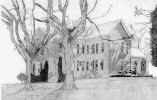 (click on picture to see an enlarged view)
FEBRUARY - (Hagan Apartments - drawn by Kenny Hunt - 11th
grade) |
Formerly known as the Butler
Apartments, located on the corner of South Third and East Maple Streets in Scottsville,
this house was built during the Civil War by a Mr. Read and originally consisted of only
the first story. The house contained a closet equipped with a trap door. Inside the closet
was an iron kettle where money and perhaps, other small valuables were hidden during the
war. Prior to 1902, Dr. John B. House, an uncle of Luther P. House, Sr., and his wife, the
former Hallie Read, bought the property and added the second story. This building housed
the first funeral home in Scottsville. T. W. Crow, Sr., and Ed Satterfield were the owners
from 1925 to 1928. Glenn Butler, whose father-in-law, a Mr. Scott, put in the natural gas
system in Scottsville, purchased the house and remodeled it into seven modern apartments
with Murphy beds. This house has a copper roof which never needs any repairs except a coat
of aluminum paint. On August 30, 1944, Dr. R. L. Hagan, a local dentist bought the house.
He and his wife lived in an apartment on the first floor and continued to operate it as an
apartment house. Dr. Hagan planted and cultivated a beautiful rose garden on that part of
the lawn which faces South Third Street. The house is presently owned by his widow, Mrs.
Irene Hagan. |
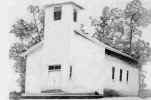 (click on picture to see an enlarged view)
MARCH - (Clifton Church - drawn by Carolyn McGuire - 11th
grade) |
Clifton General Baptist Church,
near Settle, was organized on March 8, 1878 in the old log school house which stood near
the site of the present church. Moses Jasper Bonner, a familiar name in the church history
of Allen County was instrumental in organizing the church. There were 14 charter members:
W. H. Johnson, O. Cook, W.M. Weaver, Willis Hinton, J.W. McQuire, R.B. Pulliam, Joseph
Cook, James Johnson, J.S. Weaver, J.C. Clark, S. Bunch, Thomas Oliver, j.E. Stovall, James
Hinton. Meetings were held in the school until the group was strong enough to undertake
the building of the church. Billy Johnson, farmer of the community gave the land for the
church site. It was situated at a crossroads, a central meeting place for the scattered
membership. It was a rather large frame building of peculiar construction, having a square
steeple rising all the way from the foundation, rather than from atop the building. The
entrance hall is in reality the lower part of the steeple, which opens into the
auditorium. The first pastor of the church was Elder Bird Weaver with Elder W. Weaver
serving as clerk. In 1913 R.L. Johnson, son of Billy Johnson, gave to the church a plot of
two acres for a cemetery. in 1940 plans began for a new brick church. With a lot of hard
work and divine help a new brick structure was erected on the same ground as the old one.
The old building was torn down to provide a location for the new building. While the new
building was being built, services were held in a tent in the church cemetery even though
at times it was very cold. The present pastor is Rev. Eddie Tabor. He serves a
congregation of over 200 members. |
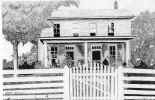 (click on picture to see an enlarged view)
APRIL - (Elijah (Lige) Reynolds Home - drawn by Stacy
Spears - 12th grade) |
This house was the first of
three homes built by the Erasmus Porter family who had acquired several hundred acres by
land grant near where East and West Bay's Fork Creeks join. The portion of the property
where this house stood was later owned by Jerry Whitney and Lon Gibson. The house which
was purchased by the Reynolds' in about 1905 stood on a rolling hill overlooking East
Bay's Fork Creek near Halifax. It contained 6 rooms and porches on three sides. The cellar
beneath the house was lined with hand hewn rocks and the chimneys were built with brick
from the kiln on the farm. There were many outbuildings with a unique barn built partially
underground. The doors to the barn stables were not hinged but swung on a post set in an
augured hole in the supporting log. Near the house was a 4 acre sugar camp where maple
syrup was made for family use. There was a water mill in operation on the Creek in front
of the house during the 1800's. Frequently, baptizings for Liberty Baptist Church were
held at this point on the Creek and the Reynolds home was used for the dressing room for
the baptismal candidates. The Reynolds home with its white-washed trees and plank fence
was a haven for many travelers in time of high water. Many times they were stranded until
the water subsided and crossing the Creek was possible at the ford in front of the house.
This was the home of Ernest Reynolds and Helen Reynolds who still reside in Allen County.
The house burned in 1966 leaving only its ashes and memories. |
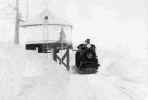 (click on picture to see an enlarged view)
MAY - (L. & N. Water Tank - drawn by Jeff Cline -
12th grade) |
The L & N water tank at
Petroleum was built when the railroad was built in the area. In the early days of the
railroad there were two trains to Scottsville every day except Sunday. A passenger train
made the run from Scottsville to Gallatin, Tennessee, every morning at six o'clock and
would return at four o'clock in the afternoon and spend the night in Scottsville. The
freight train came from Gallatin to Scottsville at ten o'clock each morning and would
return to Gallatin at noon. Both trains which were pulled by a steam locomotive, stopped
to take on water at the tank located at Petroleum. Very often, passengers would board the
train at the tank. A spring located on land owned by J.W. Ogles furnished the water for
the tank. He was the father of Lee and Warner Ogles. A concrete pool was built on the
hillside above the tracks to hold the spring water that entered the tank through an eight
inch pipe. The pool also furnished water to surrounding farms when wells went dry.
Although not uses as drinking water, it could be used for other things such as laundry,
watering stock, etc. The pool also proved to be a popular swimming hole for local boys. In
the summer, ferns grew in abundance around the tank. In the winter ice which formed on and
around the tank was chipped off by residents and used in making homemade ice cream in hand
cranked freezers. The water tank and railroad ties were removed in 1977 when rail service
to Scottsville was terminated. |
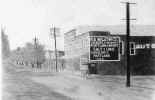 (click on picture to see an enlarged view)
JUNE - (Wilson Block - drawn by Lori Whitney - 12th grade) |
In 1895 Mr. R.
E. Wilson Sr., the father of Mrs. Frances Hummer, Mrs. Mary E. Dye of Scottsville and Mr.
Woodrow Wilson of Florida opened his first general store in this building on East Main
Street which is now Jack's Shopping Center parking lot. Goods for the store were delivered
by a horse drawn wagon. At different times the second floor of the store was used by a Mr.
Pruitt who made shoes, Mrs. W.A. Whitlow who taught a preparation course for teachers, and
as an auditorium for shows, plays, and community meetings. To the left was the Allen
County Hardware, owned by Downing and Dodson and the Landrum meal market. Across the alley
to the right was the Wilson Service station operated by G.G. Wilson, son of R.E. Wilson.
There was a blacksmith shop behind the station. The store burned in 1918. Mr. Wilson
rebuilt the store and operated it until his death in 1940. After his death the property
was sold to A.M. Davis. In 1951 the store was destroyed by fire. The service station
property was purchased by the late Irby Hummer, Jr., and later sold to Jack Turner. |
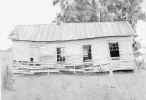 (click on picture to see an enlarged view)
JULY - (Motley School - drawn by Susan Shook - 11th grade) |
In 1895 Mr. R.
E. Wilson Sr., the father of Mrs. Frances Hummer, Mrs. Mary E. Dye of Scottsville and Mr.
Woodrow Wilson of Florida opened his first general store in this building on East Main
Street which is now Jack's Shopping Center parking lot. Goods for the store were delivered
by a horse drawn wagon. At different times the second floor of the store was used by a Mr.
Pruitt who made shoes, Mrs. W.A. Whitlow who taught a preparation course for teachers, and
as an auditorium for shows, plays, and community meetings. To the left was the Allen
County Hardware, owned by Downing and Dodson and the Landrum meal market. Across the alley
to the right was the Wilson Service station operated by G.G. Wilson, son of R.E. Wilson.
There was a blacksmith shop behind the station. The store burned in 1918. Mr. Wilson
rebuilt the store and operated it until his death in 1940. After his death the property
was sold to A.M. Davis. In 1951 the store was destroyed by fire. The service station
property was purchased by the late Irby Hummer, Jr., and later sold to Jack Turner. |
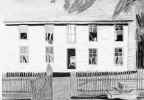 (click on picture to see an enlarged view)
AUGUST - (John Downing Home - drawn by Patty Vernon -
8th grade) |
This home was built on a 350
acre tract of land by John Seay Downing in the early 1870's. Constructed of yellow poplar
logs which were later covered by weather boarding, the original house consisted of six
rooms. Later, three additional rooms and a porch were added. Like many houses built during
this time, it contained two stairways; one for boys and one for girls. It was located on a
hill which afforded a beautiful view of Barren River in eastern Allen County. this was
once a heavily traveled section of the county and many travelers found a hospitable
welcome here when they sought lodging for the night. All thirteen of Mr. Downing's
children were born in this home. They were: Witt, Tompie, Flora Franklin, Tilda Parrish,
Bob, Sam, Warren, and Arren (twins), Carlise, Ben Carson, Esther, Belle Downing and Lena
Gatewood. He has many grandchildren living in this county today. The Downing family moved
from this home to Holland in 1908 in order to give their children a better formal
education. Upon their move, the farm was purchased by Luther Wood and Hexal Wood was born
in the house. Later, J.W. Hagan bought the farm and retained ownership until his death in
1967. When Mr. Hagan's grandson, James Ivan Pedigo was born in 1930, Mr. Hagan deeded the
farm to him. It is now owned by Mr. Pedigo's widow and his daughter, Rebekah. |
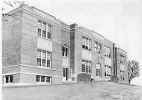 (click on picture to see an enlarged view)
SEPTEMBER - (Scottsville Elementary School 1925-1955 -
drawn by Chris Burris - 11th grade) |
Prior to the construction of
this school building in 1905, the Scottsville Elementary and High School were located in
the same building called the Scottsville Academy - a four room school built on the block
between East Walnut and E. Cherry Streets and N. Third and N. Fourth Streets. In 1900 the
academy was placed in charge of Professor John D. Spears who conceived the idea of this
modern red pressed brick school building. Construction began on August 23, 1905 and the
building was placed in use on March 1, 1906. It was erected at a cost of $10,000.00 on
land donated by J. E. Dalton. At that time and until 1925, it was used as the Scottsville
High School. Only the center of the structure was built at that time - the east and west
wings were added in the early 1920's. A picture of the school when it was first built
appears in the 1976 edition of the Scottsville Women's club calendar. This building began
serving as the Scottsville Elementary School when the Scottsville High School was built
under the leadership of N.D. Bryant in the year, 1925. It was several years later that the
seventh and eighth grades were moved to the high school. The structure was used until the
present building on the corner of Poplar and North Sixth Streets was constructed in 1955.
The old building which stood on the same lot but in a different location was then razed. |
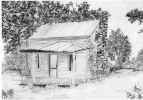 (click on picture to see an enlarged view)
OCTOBER - (Heath House - drawn by Angela Gibbs - 11th
grade) |
Home of John Marshall Heath (1831 - 1901). John was born in Washington
Co., Virginia, migrated to Campbell Co, Tn. in 1830, and then to
Jefferson Co., Tn. in 1832, then to Sumner Co., Tn. by 1846. John
Marshall Heath was the brother of William McKendred Heath (1826-1890).
Their father, Richmond R. Heath was well known gunsmith, as well as all
five of his sons. This is known as guns have been found made by all five
of them. The rifles they made were very similar in degisn. They are
had stock percussions and are very neat and attractive. It appears as
if they favored the use of walnut for the rifle stocks. All rifles made
were stamped with initials. William McKendred Heath was a gunsmith who
lived and carried on his work in the southern part of Allen County.
|
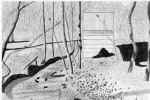 (click on picture to see an enlarged view)
NOVEMBER - (Calvert Spring - drawn by Joseph Sullivan -
8th grade) |
This remarkable spring which
furnishes most of the water for the city of Scottsville and some of the county residents
is located off the Pitchford Ridge Road on Long Creek nine miles east of Scottsville. The
water flows from a single crack in the rocks. It has a very good taste and is so pure that
very little chlorine has to be added. In former years, it was known as the Cliburn Spring
because the land on which it is located was owned by Mr. Jody Cliburn, grandfather of Mrs.
Robert B. Pitchford and Mrs. Jack Barlow. During the 1940's (WW II) when the army was here
on maneuvers, this was a popular place for the soldiers to do their laundry. During the
severe drought of the summer of 1983, when many nearby towns suffered from a water
shortage, Calvert Spring didn't fail us. It furnished more than half a million gallons of
water per day with a tremendous amount of water overflowing. A stream 40 inches wide and
14 inches deep flows off into the creek. The city has three storage tanks with a total
capacity of 760,000 gallons. The pumping system from Calvert Spring keeps those tanks
overflowing most of the time. On February 7, 1952, the Scottsville City Council adopted a
resolution to purchase the spring property from the heirs of William Washington Calvert. |
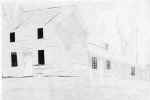 (click on picture to see an enlarged view)
DECEMBER - (Jackson Home - drawn by Donnie Renick - 12th
grade) |
At one time known as the Samuel
Jackson home, it was located off Pea Ridge Road in eastern Allen County. It was built
about 1863, as a door latch was found with this date. Samuel Jackson was born in Prince
Edward County, Virginia in 1818, the son of William and Nancy Thompson Jackson. They were
married in April, 1810 and came to Kentucky by the year 1827, when a son, John was born.
His sister, Lucy, was born in 1831. Samuel G. Jackson bought 233 acres in partnership with
his brother, John, after Samuel's first request for 7.5 acres by County Court Order. This
document was found among others, buried in the ground beneath the hen house, when the farm
was renovated in 1978. Samuel G. Jackson married Helen Lee Tinsley in 1848. She was the
daughter of Thomas and Elizabeth (Tinsley) Tinsley. Helen Lee died in February, 1864 and
is buried on the Oldridge Cliburn farm. Their children were Walter "Buck",
Warner "Pomp", Mary Elizabeth "Callie", Jane William and Lucy James
"Aunt Nig". William and Nancy Jackson were the parents of William Jr., who
married Rachel Durham; Joel who married Mary Branch, Richard, Francis, Samuel, Elizabeth
who married Paschall Weaver, Martha Ann who married John G. Whitney, John, unmarried and
crippled; Mary Jane who married Benjamin R. Corder and Lucy. According to this 1850
census, Nancy Jackson was still living with Samuel, her husband William, having passed
away in 1847. He is buried on the back of the farm in a private graveyard, where, it is
presumed Nancy is also buried. At least one other grave, that of a child, is also located
there. |